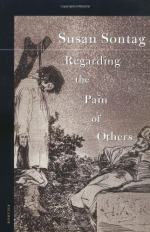
|
| Name: _________________________ | Period: ___________________ |
This quiz consists of 5 multiple choice and 5 short answer questions through Chapter 5.
Multiple Choice Questions
1. According to Sontag, photographs of atrocities are best received if they are:
(a) Close-ups of compelling scenes.
(b) So artistically simple as to seem uncomposed.
(c) Images of familiar places or people.
(d) Well-lit and high-contrast.
2. Sontag argues that the photograph, unlike the written word, is:
(a) Politically charged.
(b) Subject to interpretation.
(c) Always objective.
(d) Artistically inferior.
3. The conflicts in the Balkans in the 1990s stood out to many onlookers for which of the following reasons?
(a) The violence was more extreme than other conflicts of the era.
(b) Government propaganda incited great public interest.
(c) Most people believe that atrocities like that do not happen in Europe.
(d) The media hyped the conflicts by airing footage during each broadcast.
4. In discussing the difference gender makes in perceptions of war, Sontag agrees with which of the following authors?
(a) Henry James.
(b) Joyce Carol Oates.
(c) Virginia Woolf.
(d) Tyler Hicks.
5. Which of the following images was often thought to represent a mother, looking tellingly into the sky during an air raid of the Spanish Civil War?
(a) "Guernica."
(b) "Mother and Child, Barcelona, Spain, 1936"
(c) "Land Distribution Meeting, Extremadura, Spain, 1936"
(d) "War Against War!"
Short Answer Questions
1. Sontag claims that "good taste" is always _________ when invoked by institutions.
2. Sontag discusses reactions to the attacks on the World Trade Center on September 11, 2001. Which of the following is NOT a reaction Sontag recalls hearing?
3. At the end of World War II, a group of journalists formed Magnum Photo Agency. Which of the following photographers was not among them?
4. Images of the Gulf War were filtered to portray the "techno war." The public was exposed to only those images that portrayed which of the following sentiments?
5. Sontag argues that a photograph by which of these photographers triggered mass outcry against the Vietnam War?
|
This section contains 355 words (approx. 2 pages at 300 words per page) |

|




